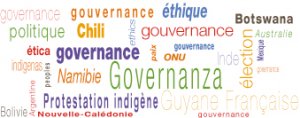

Key concepts | Governance
Governance | - 26 May 2011

The term « governance » has become widely used in political discourse as well as within social sciences although it has no accepted stable definition. Originally a Greek term meaning “to pilot”, translated into Latin it now appears in most European languages. Etymologically and historically, the notion of “governance” has been used since Plato to describe the art to govern a human collective.
While government has been more widely used, the term “governance” has made a spectacular return in the 1990s through the advocates of New Public Management and international institutions, particularly the World Bank. Within this framework, the notion of “governance” receives a normative definition with moral connotations: the concept of “good governance” underpins much of structural adjustment policies.
The resurgence of “governance” fits more widely into the contemporary globalization processes. The notion takes new meanings as a descriptive and analytical framework in a situation where decision-making power is not vested solely in the central institutions of the state but distributed through networks of stakeholders – companies, international institutions, civil society organizations, etc. As such, governance is neatly distinguished from government. It refers to the multiple agents and scales involved in a regime of power distributed through globalised processes.
In this sense, governance can be broadly conceived as “the processes, structures and Institutions (formal and informal) through which a group, community or society makes decisions, distributes and exercises authority and power, determines strategic goals, organises corporate, group and individual behaviour, develops rules and assigns responsibility” (Dodson & Smith 2003 : 1).
Indigenous Governance
The theme of governance has also become central with the development of a global movement for indigenous rights and national policies of recognition involving the formation of numerous organizations at the local, regional, national and international levels. In an indigenous context, the notion of governance can be subdivided into three categories whose articulation constitute a central issue for research:
- Indigenous governance: refers to indigenous communities and societies’ own institutions as they have been reproduced through the colonial experienceand recognized in the UNDRIP – processes of representation and decision-making, kinship networks and distribution of authority and rights, territorial organization, etc.;
- The governance of indigenousorganisations and corporations: refers to those organizations that manage and provide services to indigenous communities and more specifically to their processes and mechanisms as determined under state law and administration;
- The governance of governments: refers to the mechanisms through which governments make decisions and manage their affairs, especially with regard to their ways of enagaging with indigenous peoples for the provision of public services (e.g. education, health, housing) and the monitoring of these programs.
- Indigenous organizations have generally emerged within what is deemed a postcolonial situation. They are meant to be a vehicle for indigenous self-determination through the development of local capacities and economic opportunities. Consequently, a large part of research has been devoted to their analysis (see for instance Sterritt 2002, the Harvard Project on American Indian Economic Development, the Indigenous Community Governance Project at the Australian National University, and the Indigenous Governance Program at the University of Victoria).
Each aspect of indigenous governance has been the focus of academic attention and publications (see thematic pages). However, the analysis of the articulation between the different levels and dimensions of indigenous governance – classic, (post)colonial and state institutions, as well as international institutions and agents – remains limited.
SOGIP: scales of governance and indigenous peoples
SOGIP examines the relevance of the notion of governance with regard to the right and principle of indigenous self-determination as enshrined in the UNDRIP.
In order to go beyond the “productive misunderstanding” due to the semantic vagueness of the term, one needs to explore its use as a social fact. The Governance Analytical Framework developed by Marc Hufty (2009) is one such attempt. It is a method for the description and analysis of governance processes that provides social sciences with a useful basis for comparison.
SOGIP analyses governance as one of the elements put at stake in the political relationship defined as indigeneity. On the one hand, that of states and international institutions, the notion of “good governance” is used as a tool for the neutralization and normalization of indigenous cultural and institutional differences. On the other hand, the thinking on governance developed by indigenous organizations and societies is a source for the invention of forms of autonomy and self-determination towards a “good living”. The notion of governance thus obscures a struggle over values as a “conceptual framework that tells us something of what is desirable” (Létourneau 2009 :1). SOGIP aims to describe and analyse the underpinnings of this political tension and the manner through which it can be resolved positively for all the stakeholders.






 Version imprimable
Version imprimable